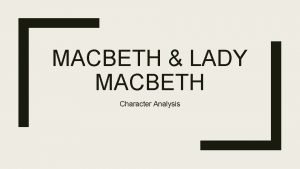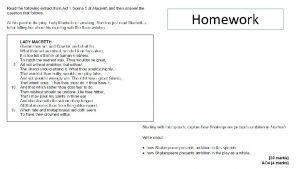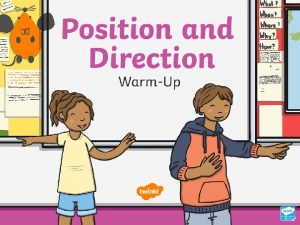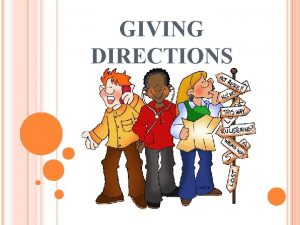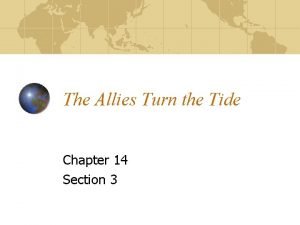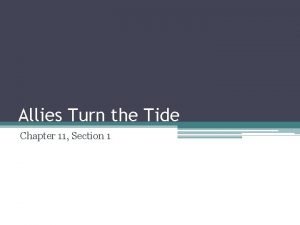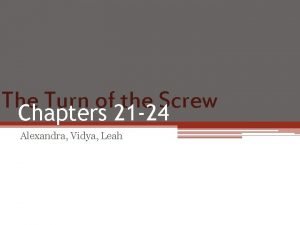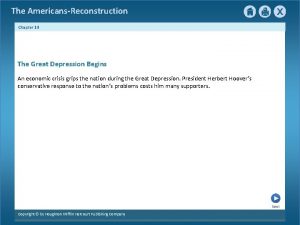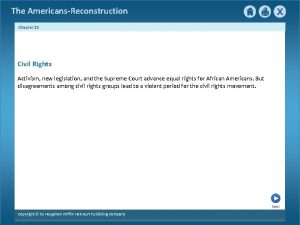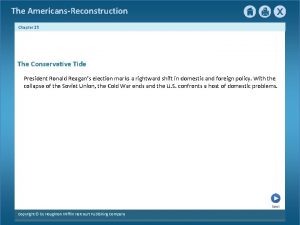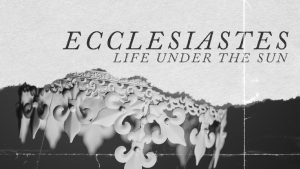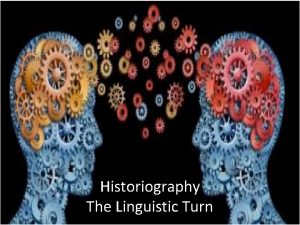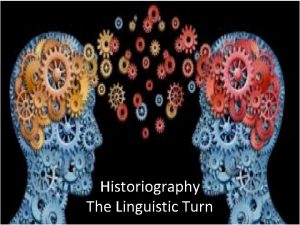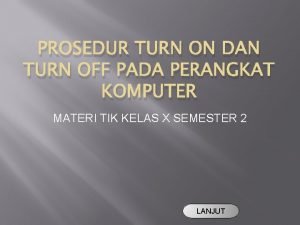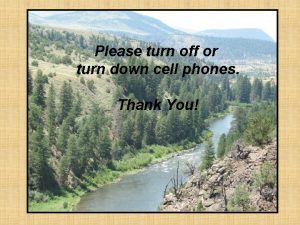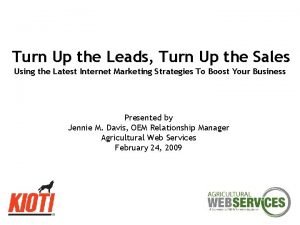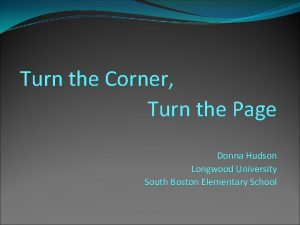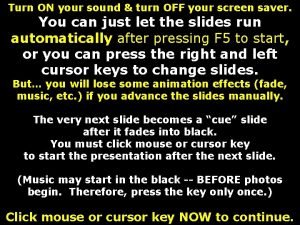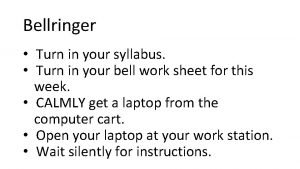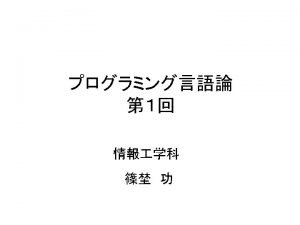The AmericansReconstruction Chapter 8 Life at the Turn




























- Slides: 28

The Americans-Reconstruction Chapter 8 Life at the Turn of the 20 th Century New technologies improve urban living, and a modern mass culture emerges. Reforms in public education raise literacy rates. African Americans work to end legal discrimination. Next Copyright © by Houghton Mifflin Harcourt Publishing Company

The Americans-Reconstruction Chapter 8 Life at the Turn of the 20 th Century SECTION 1 Science and Urban Life SECTION 2 Expanding Public Education SECTION 3 Segregation and Discrimination SECTION 4 The Dawn of Mass Culture Previous Copyright © by Houghton Mifflin Harcourt Publishing Company Next

The Americans-Reconstruction Chapter 8 Section-1 Science and Urban Life Advances in science and technology help solve urban problems, including overcrowding. Previous Copyright © by Houghton Mifflin Harcourt Publishing Company Next

The Americans-Reconstruction Chapter 8 Section-1 Science and Urban Life Technology and City Life Skyscrapers • 1890, 58 cities have 50, 000 people; 1900, 4 of 10 people in cities • Invention of elevators, internal steel skeletons lead to skyscrapers —Louis Sullivan designs Wainwright Building • Skyscrapers solve urban problem of limited, expensive space —Daniel Burnham designs Flatiron Building Continued… Previous Copyright © by Houghton Mifflin Harcourt Publishing Company Next

The Americans-Reconstruction Chapter 8 Section-1 Technology and City Life {continued} Electric Transit • Before Civil War, horse-drawn streetcars run on iron rails • By 1900, electric streetcars (trolleys) run from suburbs to downtown • Some cities build elevated trains or subways Continued… Previous Copyright © by Houghton Mifflin Harcourt Publishing Company Next

The Americans-Reconstruction Chapter 8 Section-1 Technology and City Life {continued} Engineering and Urban Planning • Steel-cable suspension bridges link city sections • Need for open spaces inspires science of urban planning • Frederick Law Olmstead spearheads movement for planned urban parks — 1857, helps design Central Park City Planning • Chicago’s population growth results in unregulated expansion • Daniel Burnham draws plan for city with parks along Lake Michigan —designs White City for 1893 World’s Columbian Exposition Previous Copyright © by Houghton Mifflin Harcourt Publishing Company Next

The Americans-Reconstruction Chapter 8 Section-1 New Technologies A Revolution in Printing • By 1890, U. S. literacy rate almost 90% • Growing demand for newspapers, magazines, books • Mills produce cheap paper that withstands high-speed presses • Faster production, lower costs make periodicals more affordable Continued… Previous Copyright © by Houghton Mifflin Harcourt Publishing Company Next

The Americans-Reconstruction Chapter 8 Section-1 New Technologies {continued} Airplanes • Orville, Wilbur Wright use engines to fly “heavier-than-air” craft —first successful flight Dec. 1903 • By 1920, first transcontinental air mail established Photography Explosion • Pre-1880 s, photography requires heavy equipment, time • George Eastman develops light-weight equipment, studio processing • 1888, introduces Kodak camera, easy to operate —millions use Kodak camera —helps create field of photojournalism Previous Copyright © by Houghton Mifflin Harcourt Publishing Company Next

The Americans-Reconstruction Chapter 8 Section-2 Expanding Public Education Reforms in public education lead to a rise in national literacy and the promotion of public education. Previous Copyright © by Houghton Mifflin Harcourt Publishing Company Next

The Americans-Reconstruction Chapter 8 Section-2 Expanding Public Education Schools for Children • 1865– 1895, states pass laws requiring school attendance for children • Kindergartens—originally childcare for working women—become popular • 1880, 62% white children, 34% black children in elementary school The Growth of High Schools • Industrial economy demands technical, managerial skills • 1900, more than half a million students in high school • Expanding education changes American society Continued… Previous Copyright © by Houghton Mifflin Harcourt Publishing Company Next

The Americans-Reconstruction Chapter 8 Section-2 Expanding Public Education {continued} Racial Discrimination • Small percentage of black teenagers attend high school • Most attend private schools that get no government support Education for Immigrants • Immigrants encouraged to attend school, be Americanized • Some resent suppression of their native languages • Many public school systems have readings from Protestant Bible —Catholics have parochial schools • Adults attend night school, some day programs at work —unionists object to employer programs Previous Copyright © by Houghton Mifflin Harcourt Publishing Company Next

The Americans-Reconstruction Chapter 8 Section-2 Expanding Higher Education Changes in Universities • By turn of century, 2. 3% of youth attend college • 1880– 1920, college enrollment more than quadruples • Research universities emerge, offer new curriculum • Professional law, medical schools established • Many public school systems have readings from Protestant Bible —some state colleges want high school diploma Continued… Previous Copyright © by Houghton Mifflin Harcourt Publishing Company Next

The Americans-Reconstruction Chapter 8 Section-2 Expanding Higher Education {continued} Higher Education for African Americans • Not enough black college graduates to meet needs of communities • Booker T. Washington—racism will end if blacks get labor skills • Heads Tuskegee Normal and Industrial Institute, now a university • W. E. B. Du Bois, first African American to get Harvard doctorate —disagrees with Washington • Founds Niagara Movement to encourage liberal arts study —believes well-educated future leaders needed Previous Copyright © by Houghton Mifflin Harcourt Publishing Company Next

The Americans-Reconstruction Chapter 8 Section-3 Segregation and Discrimination African Americans lead the fight against voting restrictions and Jim Crow laws. Previous Copyright © by Houghton Mifflin Harcourt Publishing Company Next

The Americans-Reconstruction Chapter 8 Section-3 Segregation and Discrimination African Americans Fight Legal Discrimination Voting Restrictions • For at least 10 years after Reconstruction, Southern blacks can vote • By 1900, all Southern states restrict voting, deny equality • Some limit vote to those who can read; officials give literacy tests • Some have poll tax that must be paid annually to vote • Some add grandfather clause to constitution to let poor whites vote —can vote if self, father, grandfather voted before 1867 Continued… Previous Copyright © by Houghton Mifflin Harcourt Publishing Company Next

The Americans-Reconstruction Chapter 8 Section-3 African Americans Fight Legal Discrimination {continued} Jim Crow Laws • 1870 s, 1880 s, Supreme Court allows poll tax, grandfather clause • Racial segregation laws separate races in private, public places • Segregation laws called Jim Crow laws after old minstrel song Plessy v. Ferguson • 1896 Plessy v. Ferguson—segregation legal in public places • Allows “separate but equal” doctrine if provide equal service Previous Copyright © by Houghton Mifflin Harcourt Publishing Company Next

The Americans-Reconstruction Chapter 8 Section-3 Turn-of-the-Century Race Relations Opposing Discrimination • Racial etiquette—informal rules for black-white relations — enforce second-class status for blacks • Moderate reformers, like Booker T. Washington, get white support • W. E. B. Du Bois, Ida B. Wells think problems too urgent to postpone • Born a slave, Ida B. Wells becomes teacher, newspaper editor — campaigns for racial justice Continued… Previous Copyright © by Houghton Mifflin Harcourt Publishing Company Next

The Americans-Reconstruction Chapter 8 Section-3 Turn-of-the-Century Race Relations Violence • African Americans who do not follow etiquette are punished, lynched — more than 1, 400 killed 1882– 1892 Discrimination in the North • Many blacks migrate North for better paying jobs, social equality • Are forced into segregated neighborhoods • Rejected by labor unions; hired last, fired first by employers • Competition between blacks, working-class whites sometimes violent Previous Copyright © by Houghton Mifflin Harcourt Publishing Company Next

The Americans-Reconstruction Chapter 8 Section-3 Discrimination in the West Mexican Workers • More Mexicans build railroads in Southwest than other ethnic groups — forced to work for less than other groups • Mexicans major force in Southwest agricultural industries • Some Southwest Mexicans, African Americans forced into debt peonage: — system of slavery to work off debt to employer — 1911, Supreme Court declares unconstitutional Excluding the Chinese • Whites fear job competition, push Chinese to separate areas, schools • Opposition to Chinese immigration leads to Chinese Exclusion Act Previous Copyright © by Houghton Mifflin Harcourt Publishing Company Next

The Americans-Reconstruction Chapter 8 Section-4 The Dawn of Mass Culture As Americans have more time for leisure activities, a modern mass culture emerges. Previous Copyright © by Houghton Mifflin Harcourt Publishing Company Next

The Americans-Reconstruction Chapter 8 Section-4 The Dawn of Mass Culture American Leisure Amusement Parks • Cities begin setting aside green space for recreation • Amusement parks built on outskirts with picnic grounds, rides Bicycling and Tennis • Early bicycles dangerous; at first, bicycling is male-only sport • Safety bicycle increases popularity of sport; women ride too • Tennis imported from Britain; becomes popular Continued… Previous Copyright © by Houghton Mifflin Harcourt Publishing Company Next

The Americans-Reconstruction Chapter 8 Section-4 American Leisure {continued} Spectator Sports • Americans become avid fans of spectator sports • By turn of century, boxing, baseball become profitable businesses Baseball • 1845, Alexander J. Cartwright organizes club, sets down rules • National League forms 1876; American League forms 1900 • Discrimination leads to Negro National, Negro American Leagues Previous Copyright © by Houghton Mifflin Harcourt Publishing Company Next

The Americans-Reconstruction Chapter 8 Section-4 The Spread of Mass Culture Mass Circulation Newspapers • Newspapers use sensational headlines, stories to capture readers • Joseph Pulitzer buys New York World, pioneers popular innovations • William Randolph Hearst—NY, San Francisco papers exaggerate stories Promoting Fine Arts • Artists like Thomas Eakins promote realism—portray life as it is • Ashcan School paints urban life, working people • European abstract art introduced; many find difficult to understand Continued… Previous Copyright © by Houghton Mifflin Harcourt Publishing Company Next

The Americans-Reconstruction Chapter 8 Section-4 The Spread of Mass Culture {continued} Popular Fiction • By 1900, thousands of free circulating libraries in country • Most people like dime novels—glorified adventure tales of the West • Some want more serious, realistic portrayal of ordinary people, life • Novelist, humorist Samuel Langhorne Clemens, or Mark Twain: — rejects high culture yet writes American classics • Galleries, libraries try to raise cultural standards Previous Copyright © by Houghton Mifflin Harcourt Publishing Company Next

The Americans-Reconstruction Chapter 8 Section-4 New Ways to Sell Goods Urban Shopping • 1890, first shopping center opens in Cleveland—glass-topped arcade • Retail shopping districts form near public transportation The Department Store • 1865, Marshall Field opens first U. S. department store in Chicago — stresses personal service — pioneers bargain basement Continued… Previous Copyright © by Houghton Mifflin Harcourt Publishing Company Next

The Americans-Reconstruction Chapter 8 Section-4 New Ways to Sell Goods {continued} The Chain Store • Chain stores offer same merchandise under same owners for less — buy in quantity, limit personal service Advertising • Advertising explosion: $10 million spent 1865, $95 million 1900 • Advertising in periodicals, billboards, sides of buildings Catalogs and RFD • Montgomery Ward, Sears Roebuck catalogs bring goods to small towns • Rural free delivery (RFD)—post office delivers direct to every home Previous Copyright © by Houghton Mifflin Harcourt Publishing Company Next

The Americans-Reconstruction Chapter 8 This is the end of the chapter presentation of lecture notes. Click the HOME or EXIT button. Previous Copyright © by Houghton Mifflin Harcourt Publishing Company Next

The Americans-Reconstruction Chapter 8 Print Slide Show 1. On the File menu, select Print 2. In the pop-up menu, select Microsoft Power. Point If the dialog box does not include this pop-up, continue to step 4 3. In the Print what box, choose the presentation format you want to print: slides, notes, handouts, or outline 4. Click the Print button to print the Power. Point presentation Previous Copyright © by Houghton Mifflin Harcourt Publishing Company
 You can't turn right here you turn left
You can't turn right here you turn left Turn hell hound turn
Turn hell hound turn Answer. go straight turn left turn right
Answer. go straight turn left turn right What is 1/4 turn clockwise
What is 1/4 turn clockwise Turn hell hound turn
Turn hell hound turn Turn hell hound turn
Turn hell hound turn Go straight turn left turn right
Go straight turn left turn right Themes about guilt
Themes about guilt Atomatoeflames
Atomatoeflames Put your right hand in
Put your right hand in Go straight ahead then turn left
Go straight ahead then turn left How did the allies turn the tide against the axis
How did the allies turn the tide against the axis Turn the tide chapter 1
Turn the tide chapter 1 The turn of the screw summary chapter 1
The turn of the screw summary chapter 1 Hình ảnh bộ gõ cơ thể búng tay
Hình ảnh bộ gõ cơ thể búng tay Ng-html
Ng-html Bổ thể
Bổ thể Tỉ lệ cơ thể trẻ em
Tỉ lệ cơ thể trẻ em Gấu đi như thế nào
Gấu đi như thế nào Tư thế worm breton là gì
Tư thế worm breton là gì Chúa yêu trần thế
Chúa yêu trần thế Các môn thể thao bắt đầu bằng từ đua
Các môn thể thao bắt đầu bằng từ đua Thế nào là hệ số cao nhất
Thế nào là hệ số cao nhất Các châu lục và đại dương trên thế giới
Các châu lục và đại dương trên thế giới Công thức tính độ biến thiên đông lượng
Công thức tính độ biến thiên đông lượng Trời xanh đây là của chúng ta thể thơ
Trời xanh đây là của chúng ta thể thơ Cách giải mật thư tọa độ
Cách giải mật thư tọa độ Phép trừ bù
Phép trừ bù Phản ứng thế ankan
Phản ứng thế ankan




